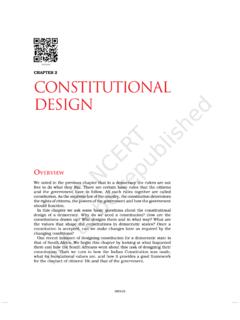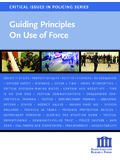Transcription of Separation of Powers: An Overview - FAS
1 Separation of Powers: An Overview Matthew E. Glassman Analyst on the Congress January 8, 2016 Congressional Research Service 7-5700 R44334 Separation of Powers: An Overview Congressional Research Service Summary Congress s role and operation in national politics is fundamentally shaped by the design and structure of the governing institution in the Constitution. One of the key principles of the Constitution is Separation of powers. The doctrine is rooted in a political philosophy that aims to keep power from consolidating in any single person or entity, and a key goal of the framers of the Constitution was to establish a governing system that diffused and divided power.
2 These objectives were achieved institutionally through the design of the Constitution. The legislative, executive, and judicial branches of the government were assigned distinct and limited roles under the Constitution, and required to be comprised of different political actors. The constitutional structure does not, however, insulate the branches from each other. While the design of the Constitution aims, through Separation , to prevent the centralization of power, it also seeks the same objective through diffusion. Thus, most powers granted under the Constitution are not unilateral for any one branch; instead they overlap.
3 The constitutional structure of Separation of powers invites conflict between the branches, particularly between Congress and the President. The electoral structure of the federal government provides not only separate bases of authority, but also different bases of authority for political actors, as well as different time horizons. Likewise, the assignment of powers under the Constitution is not only overlapping, but also somewhat vague, creating inter-branch contests for power across many key functions of the government. Finally, numerous questions of authority are not even addressed by the Constitution.
4 Although each branch has strong incentives to protect its prerogatives, in many cases individual political actors have incentives that run counter to their institutional affiliation. In particular, political actors will often, quite reasonably, place the short-term achievement of substantive policy goals ahead of the long-term preservation of institutional power for their branch of government. Likewise, partisan or ideological affiliations will at times place political actors at cross purposes, where they will be forced to choose between those affiliations and their branch affiliation.
5 Such anti-branch incentives are important contours to consider for political actors seeking to increase the power of their own branch. The problem of institutional power coming into conflict with other goals is particularly acute for Congress, especially in relation to the executive branch. As individual members of a large body, Representatives and Senators may not believe they have the responsibility or the capacity to defend the institution. Those who may feel such responsibility, such as party and chamber leaders, will often find themselves in situations in which policy or party goals, either their own personal ones or those of their caucus, come into direct conflict with institutional goals.
6 Even when Congress does choose to institutionally defend itself, it often finds itself speaking with less than a unified voice, as only the most vital institutional powers have the ability to unify Congress. This report provides an Overview of Separation of powers. It first reviews the philosophical and political origins of the doctrine. Then it surveys the structure of Separation of power in the Constitution. It next discusses the consequences of the system, for both the institutions and for individual political actors. Finally, there is a discussion of Separation of powers in the context of contemporary politics.
7 Separation of Powers: An Overview Congressional Research Service Contents Introduction .. 1 The American System in Global Context .. 1 Conflict by design .. 2 Separation of Powers: Origins .. 2 Philosophical Roots .. 3 Functions of Government .. 3 Enlightenment Thought .. 4 Colonial Experiences .. 5 Colonial Government .. 5 Revolutionary Grievances .. 6 Early American Challenges .. 6 The Framers in Context .. 7 Separation of Powers: Structure .. 8 Separate Institutions .. 8 Distinct Roles and Authority .. 8 Separate Personnel .. 8 Independent Electoral Bases.
8 9 Independent Resources and Support .. 9 Checks and Balances .. 10 Overlapping Responsibility .. 10 Appointment and Removal Authority .. 10 Investigations .. 11 War and Foreign 11 Separation of Powers: Consequences .. 12 Conflict .. 12 Separate Bases of Authority, but Also Different Bases of 12 Vague Powers .. 13 Unconsidered Questions .. 14 Institutional Power .. 14 Asserting and Guarding Power .. 14 Public Prestige .. 15 Political Capacity .. 15 Consequences for Individual Political Actors .. 16 Cross-Purposes .. 16 A Particularly Congressional Problem.
9 17 Lessons for Those Seeking to Increase Institutional Power .. 17 Contemporary Issues .. 18 Concluding Observations .. 19 Contacts Author Contact Information .. 20 Separation of Powers: An Overview Congressional Research Service 1 Introduction Congress s role and operation in national politics is fundamentally shaped by the design and structure of the governing institutions in the Constitution. One of the key principles of the Constitution is Separation of powers. The doctrine is rooted in a political philosophy that aims to keep power from consolidating in any single person or entity, and a key goal of the framers of the Constitution was to establish a governing system that diffused and divided power.
10 Experience with the consolidated power of King George III had led them to believe that the accumulation of legislative, executive, and judicial powers in the same hands .. [was] the very definition of tyranny. 1 These objectives were achieved institutionally through the constitutional Separation of powers. The legislative, executive, and judicial branches of the government were assigned distinct and limited roles under the Constitution, and required to be comprised of different political actors. The elected branches have separate, independent bases of authority, and specific safeguards prevent any of the branches from gaining undue influence over another.













